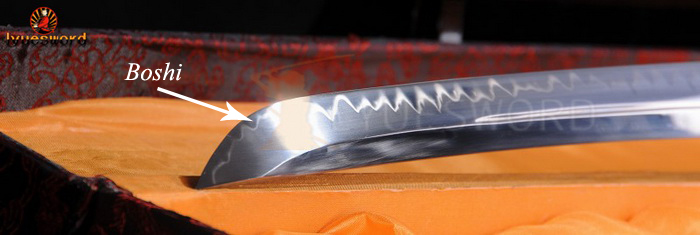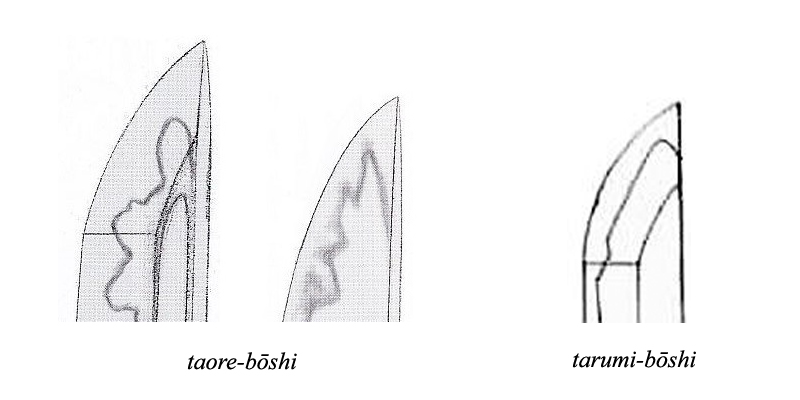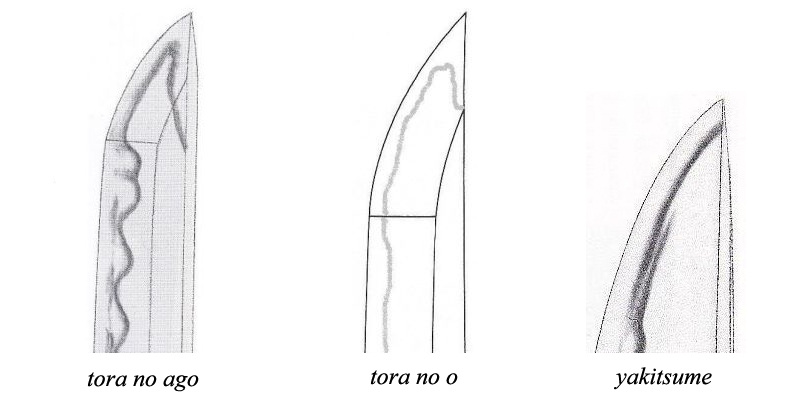By lyuesword | 20 October 2020 | 1 Comments
Common Types of Boshi- the temper line in kissaki
Common Types of Boshi
Boshi is the hamon temper line that extends to the blade tip (kissaki) on Japanese Swords. Boshi is the hardened edge section of the tip. Swords that have not been differentially hardened do not have boshi. An ideally shaped boshi follows the rest of the hamon pattern and turns back on itself widely at the blade point, usually touching the yokote which is the dividing line where the surfaces change between the blade and the tip.

These are some more common styles of boshi on the katana swords:

Aoe-bōshi (青江帽子) – Special bōshi interpretation appearing with the Chū-Aoe school which is undulating, shows a tight nioiguchi, and whose smallish ko-maru-kaeri turns relative abruptly and rather pointed and runs back straight back to the mune.
hakikake-bōshi (掃掛け帽子) – Bōshi whose main characteristic feature are hakikake. However, a bōshi with an even larger amount of hakikake is usually referred to as kaen (火炎).
ichimai-bōshi (一枚帽子) – A fully or almost fully tempered kissaki. In some cases part of the outline of the bōshi is still discernible somewhere in the kissaki area. That means, the kissaki is not completely hardened and a kaeri can be seen somewhere very close to the mitsukado (the point where yokote, shinogi, and ko-shinogi merge). The transitions between an ichimai-bôshi and a bôshi with a pronounced yaki ga fukai are fluid.

ichimonji-kaeri (一文字返り) – Bōshi where the kaeri sets off in a straight manner towards the mune and does not run back along the back (or runs back only very little).
jizō-bōshi (地蔵帽子) – Bōshi which appars more or less as midare-komi but with a sharply constricted kaeri area that makes it look like a profile of a statue of the Bodhisattva Jizō. A jizō-bōshi is particularly typical for Mino blades.
kaen (火焔・火炎) – Lit. "flame, blaze". Very nie-laden bōshi with an abundance of hakikake which looks like flames. Sometimes also referred to as kaen-gashira (火焔頭・火炎頭, lit. "head in flames").

ko-maru (小丸) – Small roundish kaeri.
midare-komi (乱れ込み) – Irregular, midare-based bōshi.
Mishina-bōshi (三品帽子) – Basically a variant of the sansaku-bōshi but with a kaeri that looks like a narrow jizō-style kaeri. This bōshi interpretation was often applied by smiths in the vicinity of the Mishina school, thus the name.
nie-kuzure (沸崩れ) – A heavily nie-laden bôshi that appears frayed so that it is hard to define the habuchi or outline, or in extreme nie-kuzure cases no outline can be made out at all. A nie-kuzure is often seen on Sôshû blades and at schools and smiths who worked in or were influenced by the Sôshû tradition, for example the Hasebe (長谷部) and Nobukuni (信国) schools, Shikkake Norinaga (尻懸則長), and the Sôden-Bizen, Horikawa, and Satsuma-shintô smiths, just to name a few. The transition between nie-kuzure, much hakikake, and kaen are fluid. A nie-kuzure bôshi might also tend to a nie-based ichimai-bôshi if the entire kissaki is thickly covered in nie.

notare-komi (湾れ込み) – A slightly undulating, notare-based bōshi.
ō-maru (大丸) – Large roundish kaeri.
sansaku-bōshi (三作帽子) – Lit. "bōshi of the Three Great (Osafune) Masters" which were Nagamitsu (長光), Kagemitsu (景光), and Sanenaga (真長) as they were known for applying this kind of bōshi. It is formed by a suguha that runs shortly straight and unchangedly over the yokote and follows then in a slightly undulating manner the fukura to turn back in a compact ko-maru-kaeri.
taki no otoshi (滝の落し・瀧の落し) – Bōshi with a long and rather oblique kaeri which reminds of a waterfall (taki). This kind of bōshi is usually associated with Mihara blades.

taore-bōshi (倒れ帽子) – Lit. "falling bōshi". Bōshi interpretation where the kaeri leans towards the ha. A typical feature of Sue-Seki blades (bottom picture left) or of Sa Yasuyoshi (安吉) (bottom picture right). Their bôshi looks like a jizô-bôshi with Jizô's head leaning towards the ha but with the difference that Jizô's head is by trend more pointed at the Sa smiths. Please note that a bōshi with a kaeri that approaches the cutting edge due to loss of material is also referred to as taore-bōshi. Thus one has to be careful using this term and specify if in a reference to an altered kissaki or to a characteristic feature of certain smiths.
tarumi-bōshi (弛み帽子) – Lit. "slackening, relaxing bōshi". Sugu-bōshi that is actually straight or, if undulating, that does not run parallel the fukura. In exaggerated terms, the bōshi is "tired" and has to "relax" and goes thus the short way, which is straight, to the kaeri. For example, a sansaku and a Mishina-bōshi come under the category of a tarumi-bōshi.

togari-bôshi (尖り帽子) – As mentioned, a bôshi with a noticeably pointed kaeri. A form of the togari-bôshi is the rōsoku-bōshi (蝋燭帽子) which is basically a midare-komi bōshi with a quite pointed kaeri, mostly with plenty of nioi, which reminds of a candle wick (rōsoku no shin), thus sometimes also referred to as rōsoku no shin (蝋燭の芯) instead of rôsoku-bôshi. This bōshi interpretation is typical for Osafune Kanemitsu (兼光) and the Ōei-Bizen school (bottom picture left). And a noticeably pointed kaeri that tends to rôsoku which comes in combination with plenty of nie and a long and rather wide kaeri is typical for Chôgi (長義), thus also the term Chôgi-bôshi exists to refer to his peculiar togari-bôshi interpretation (bottom picture center). And a togari-bôshi is also a typical feature of the Sa (左) school where in their case, the rôsoku part is a hint wider at the base than at the Kanemitsu and Ôei-Bizen schools (bottom picture right).

tora no ago (虎の顎) – Lit. “tiger chin.” Term to refer to a bōshi interpretation seen on blades by Kotetsu (虎徹) and smiths in his scholastic vicinity where the hamon shows a double yakikomi right before the yokote and runs after the ridge more or less parallel along the fukura to a ko-maru-kaeri. The name goes back to the similarity of the "yakikomi" to a tiger's chin.
tora no o (虎の尾) – Bōshi with a more or less long kaeri that runs parallel to the mune and ends abruptly and roundish. This kind of bōshi reminds of the tail (o) of a tiger (tora) and is usually associated with Ko-Mihara blades.
yakitsume (焼詰め) – Also pronounced as yakizume. A bōshi where the hamon runs out without kaeri. The yakizume itself can be sugu or midare-komi and accompanied by various hataraki.
Want a unique sword? Feel free to contact us:
Email: lyuesword@hotmail.com
Website: www.lyuesword.com
Custom Sword Page: www.lyuesword.com/Custom-Sword/customization-options/Create-Your-Own-Swords
Boshi is the hamon temper line that extends to the blade tip (kissaki) on Japanese Swords. Boshi is the hardened edge section of the tip. Swords that have not been differentially hardened do not have boshi. An ideally shaped boshi follows the rest of the hamon pattern and turns back on itself widely at the blade point, usually touching the yokote which is the dividing line where the surfaces change between the blade and the tip.

These are some more common styles of boshi on the katana swords:

Aoe-bōshi (青江帽子) – Special bōshi interpretation appearing with the Chū-Aoe school which is undulating, shows a tight nioiguchi, and whose smallish ko-maru-kaeri turns relative abruptly and rather pointed and runs back straight back to the mune.
hakikake-bōshi (掃掛け帽子) – Bōshi whose main characteristic feature are hakikake. However, a bōshi with an even larger amount of hakikake is usually referred to as kaen (火炎).
ichimai-bōshi (一枚帽子) – A fully or almost fully tempered kissaki. In some cases part of the outline of the bōshi is still discernible somewhere in the kissaki area. That means, the kissaki is not completely hardened and a kaeri can be seen somewhere very close to the mitsukado (the point where yokote, shinogi, and ko-shinogi merge). The transitions between an ichimai-bôshi and a bôshi with a pronounced yaki ga fukai are fluid.

ichimonji-kaeri (一文字返り) – Bōshi where the kaeri sets off in a straight manner towards the mune and does not run back along the back (or runs back only very little).
jizō-bōshi (地蔵帽子) – Bōshi which appars more or less as midare-komi but with a sharply constricted kaeri area that makes it look like a profile of a statue of the Bodhisattva Jizō. A jizō-bōshi is particularly typical for Mino blades.
kaen (火焔・火炎) – Lit. "flame, blaze". Very nie-laden bōshi with an abundance of hakikake which looks like flames. Sometimes also referred to as kaen-gashira (火焔頭・火炎頭, lit. "head in flames").

ko-maru (小丸) – Small roundish kaeri.
midare-komi (乱れ込み) – Irregular, midare-based bōshi.
Mishina-bōshi (三品帽子) – Basically a variant of the sansaku-bōshi but with a kaeri that looks like a narrow jizō-style kaeri. This bōshi interpretation was often applied by smiths in the vicinity of the Mishina school, thus the name.
nie-kuzure (沸崩れ) – A heavily nie-laden bôshi that appears frayed so that it is hard to define the habuchi or outline, or in extreme nie-kuzure cases no outline can be made out at all. A nie-kuzure is often seen on Sôshû blades and at schools and smiths who worked in or were influenced by the Sôshû tradition, for example the Hasebe (長谷部) and Nobukuni (信国) schools, Shikkake Norinaga (尻懸則長), and the Sôden-Bizen, Horikawa, and Satsuma-shintô smiths, just to name a few. The transition between nie-kuzure, much hakikake, and kaen are fluid. A nie-kuzure bôshi might also tend to a nie-based ichimai-bôshi if the entire kissaki is thickly covered in nie.

notare-komi (湾れ込み) – A slightly undulating, notare-based bōshi.
ō-maru (大丸) – Large roundish kaeri.
sansaku-bōshi (三作帽子) – Lit. "bōshi of the Three Great (Osafune) Masters" which were Nagamitsu (長光), Kagemitsu (景光), and Sanenaga (真長) as they were known for applying this kind of bōshi. It is formed by a suguha that runs shortly straight and unchangedly over the yokote and follows then in a slightly undulating manner the fukura to turn back in a compact ko-maru-kaeri.
taki no otoshi (滝の落し・瀧の落し) – Bōshi with a long and rather oblique kaeri which reminds of a waterfall (taki). This kind of bōshi is usually associated with Mihara blades.

taore-bōshi (倒れ帽子) – Lit. "falling bōshi". Bōshi interpretation where the kaeri leans towards the ha. A typical feature of Sue-Seki blades (bottom picture left) or of Sa Yasuyoshi (安吉) (bottom picture right). Their bôshi looks like a jizô-bôshi with Jizô's head leaning towards the ha but with the difference that Jizô's head is by trend more pointed at the Sa smiths. Please note that a bōshi with a kaeri that approaches the cutting edge due to loss of material is also referred to as taore-bōshi. Thus one has to be careful using this term and specify if in a reference to an altered kissaki or to a characteristic feature of certain smiths.
tarumi-bōshi (弛み帽子) – Lit. "slackening, relaxing bōshi". Sugu-bōshi that is actually straight or, if undulating, that does not run parallel the fukura. In exaggerated terms, the bōshi is "tired" and has to "relax" and goes thus the short way, which is straight, to the kaeri. For example, a sansaku and a Mishina-bōshi come under the category of a tarumi-bōshi.

togari-bôshi (尖り帽子) – As mentioned, a bôshi with a noticeably pointed kaeri. A form of the togari-bôshi is the rōsoku-bōshi (蝋燭帽子) which is basically a midare-komi bōshi with a quite pointed kaeri, mostly with plenty of nioi, which reminds of a candle wick (rōsoku no shin), thus sometimes also referred to as rōsoku no shin (蝋燭の芯) instead of rôsoku-bôshi. This bōshi interpretation is typical for Osafune Kanemitsu (兼光) and the Ōei-Bizen school (bottom picture left). And a noticeably pointed kaeri that tends to rôsoku which comes in combination with plenty of nie and a long and rather wide kaeri is typical for Chôgi (長義), thus also the term Chôgi-bôshi exists to refer to his peculiar togari-bôshi interpretation (bottom picture center). And a togari-bôshi is also a typical feature of the Sa (左) school where in their case, the rôsoku part is a hint wider at the base than at the Kanemitsu and Ôei-Bizen schools (bottom picture right).

tora no ago (虎の顎) – Lit. “tiger chin.” Term to refer to a bōshi interpretation seen on blades by Kotetsu (虎徹) and smiths in his scholastic vicinity where the hamon shows a double yakikomi right before the yokote and runs after the ridge more or less parallel along the fukura to a ko-maru-kaeri. The name goes back to the similarity of the "yakikomi" to a tiger's chin.
tora no o (虎の尾) – Bōshi with a more or less long kaeri that runs parallel to the mune and ends abruptly and roundish. This kind of bōshi reminds of the tail (o) of a tiger (tora) and is usually associated with Ko-Mihara blades.
yakitsume (焼詰め) – Also pronounced as yakizume. A bōshi where the hamon runs out without kaeri. The yakizume itself can be sugu or midare-komi and accompanied by various hataraki.
Want a unique sword? Feel free to contact us:
Email: lyuesword@hotmail.com
Website: www.lyuesword.com
Custom Sword Page: www.lyuesword.com/Custom-Sword/customization-options/Create-Your-Own-Swords
Recently Reviews
Read MoreLeave a Reply
Your email address will not be published.Required fields are marked. *
TAGS